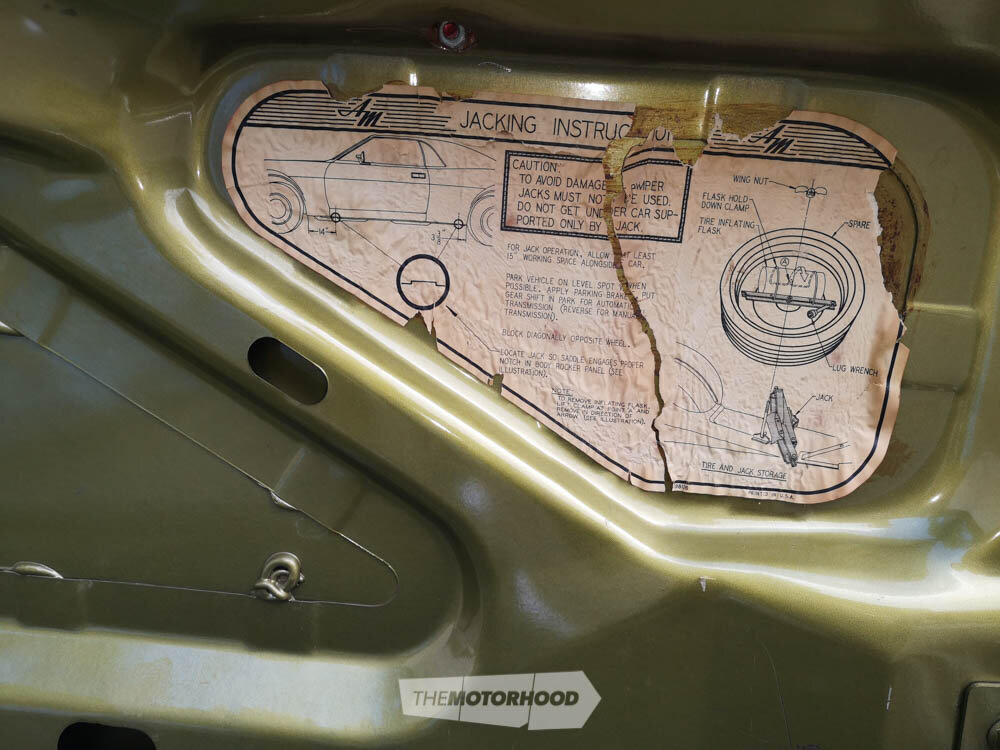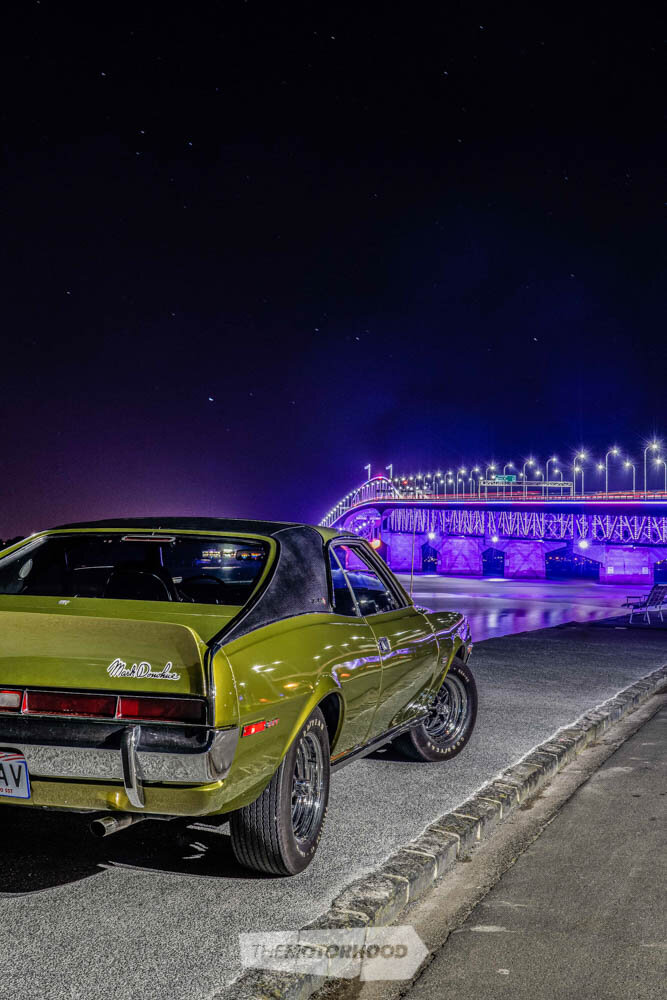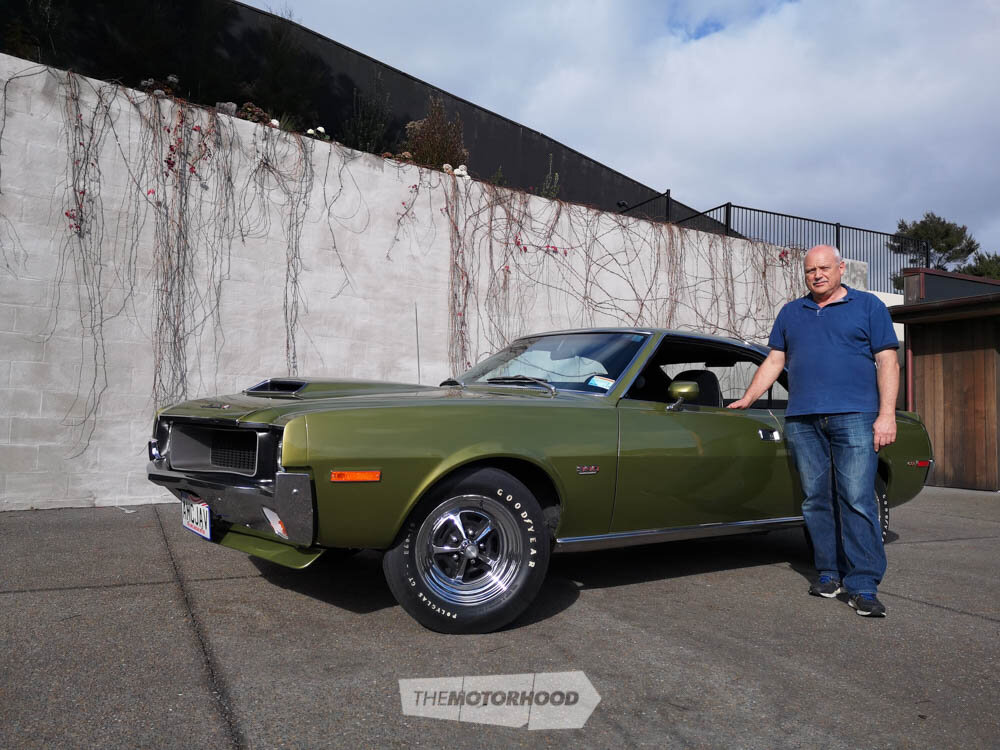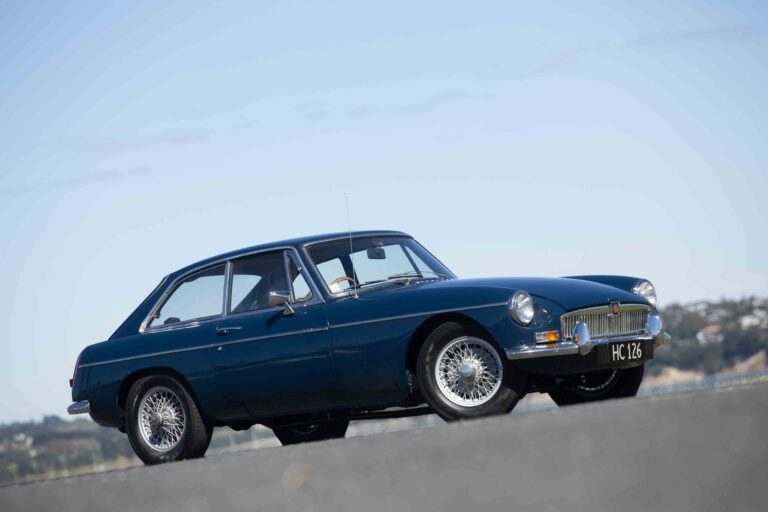If there is such a thing as a subtle muscle car, the AMC Javelin is a strong contender
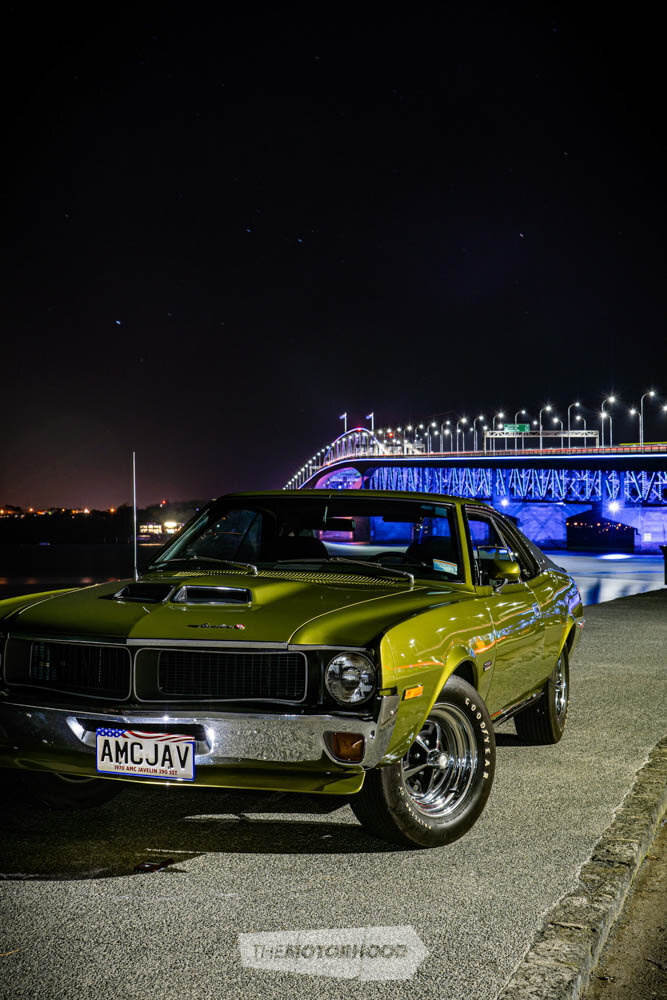
Its lines are undeniably muscular with period-correct bulging haunches and the long fastback flying buttresses. This first-generation AMC Javelin also has an era-defining, deeply recessed, squared-off ‘venturi’ grille. The pillarless doors create a perfectly proportioned aperture when the front and rear windows are wound down, and it has the correct big V8 rumble from its twin tail pipes.
This 1970 example’s Golden Lime paint is also pitch-perfect, straddling both the ’60s and ’70s, familiar and unfamiliar at the same time. It looks right but you won’t recognize it as a standard colour from any of the big three American motor manufacturers. Which is another subtle success because the car was made by a company actually called ‘American Motors Corporation’ (AMC).
Owner Donald Webster says the reaction from almost everyone, and especially from muscle car fans, is, “What is it?”
It’s something of a coup to have a coupé that is undeniably a muscle car — almost a perfect expression of the genre if you don’t subscribe to the bigger-is-always-better mantra — yet which is bafflingly unknown.
Donald rates it above Mustangs, which, for all their popularity, aren’t famous for their handling. Donald’s not a fan of American cars’ driving dynamics; he finds Mustangs impossibly vague. He drove a ’67 Mustang not overly endowed with the kind of power that can get you into trouble, but Donald, who is a keen participant in the annual Targa New Zealand tarmac rally and therefore no mean wheelman, said he “never knew where it was going to go”.
Best handling
The Javelin, he says, is much better behaved, and in fact, at the time it was introduced, it was considered the best-handling muscle car of the era. A sobering thought. However, that good behaviour doesn’t extend to the wet. It wears the white-lettered Goodyear Polyglas tyres on its Rostyle-style wheels that were standard on this up-specced car. Perhaps rain is so infrequent in the American heartland and on the West Coast that the Polyglas designers didn’t bother about wet-weather performance. Or maybe the rubber has hardened with age. Either way, one cold wet dark evening after retrieving the car from his favourite mechanic, who had replaced all the hoses and rubberware throughout the car, except the tyres, Donald called him up to complain.
He demanded to know what the mechanic, Bert, had done to the steering.
The slightly flustered mechanic said, “Nothing, why?”
“Because it now steers from the back!” Donald told him, earning an appropriate riposte from the relieved Bert.
Another of Donald’s cars has already appeared in this magazine. The cover of our March issue (No. 351) featured both his 1971 Alpine Renault and his 2018 Renault Alpine. The inversion of the name order is correct, after Renault bought Alpine in 1974. The new car is Renault’s gorgeous tribute to the gorgeous original. The older car won Monte Carlo and the new one, multiple car of the year awards. It is a genuine Porsche challenger in its performance and handling.
Donald also owns and drives a couple of Peugeot 106 Rallyes, one of the sharpest-handling GTi-inspired cars ever built. In fact Donald says the 106 out-handles, out-accelerates, and out-brakes the Javelin on all points of the compass. So most people are very surprised that the AMC Javelin held any appeal for him.
All in the family
But Donald is maintaining a strong family tradition. Previous generations of his family part-owned Campbell Motors, which distributed Peugeot in New Zealand, and later acquired the rights to distribute AMC products, which for New Zealand meant Rambler and Jeep. Jeep was an AMC brand that became majority controlled by Renault (another link with his Alpines) until it was bought by Chrysler, which is also now part of a conglomerate with Renault. Donald’s father was apparently some kind of visionary, creating American and French automotive connections well ahead of the pack.
The Ramblers had their fans here and in the US, but Donald says most of its cars were very dull. AMC was formed in 1954 when the Hudson car company got together with Nash-Kelvinator before dropping both of those brand names in favour of Rambler and Metropolitan. The Nash Metropolitan was one of its cars, made in the UK.
AMC focused on smaller cars for the practically minded, and based in Kenosha, Wisconsin, the company was suitably at arm’s length from the big three in Detroit. In fact one of its chairmen, George W Romney, father of current politician Mitt Romney, coined the phrase “gas-guzzling dinosaurs” to describe the products of Ford, General Motors (GM), and Chrysler. While AMC was known for producing basic cars it was still innovative and introduced folding back seats, disc brakes, and air conditioning across the range, sometimes years before its competitors. It was experimenting with electric cars as far back as 1959 too.
The company acquired Jeep later but the AMC brand is probably best known for the ’70s AMC Gremlins and the Pacer, the world’s first wide subcompact car, which featured as the ‘Mirthmobile’ in the Wayne’s World films. With such alternative DNA, it’s somewhat surprising that AMC produced such a conventional car as the Javelin and its shorter two-seater cousin, the AMX, in 1968 — although the huge success of the Mustang and Camaro pony cars was incentive enough.

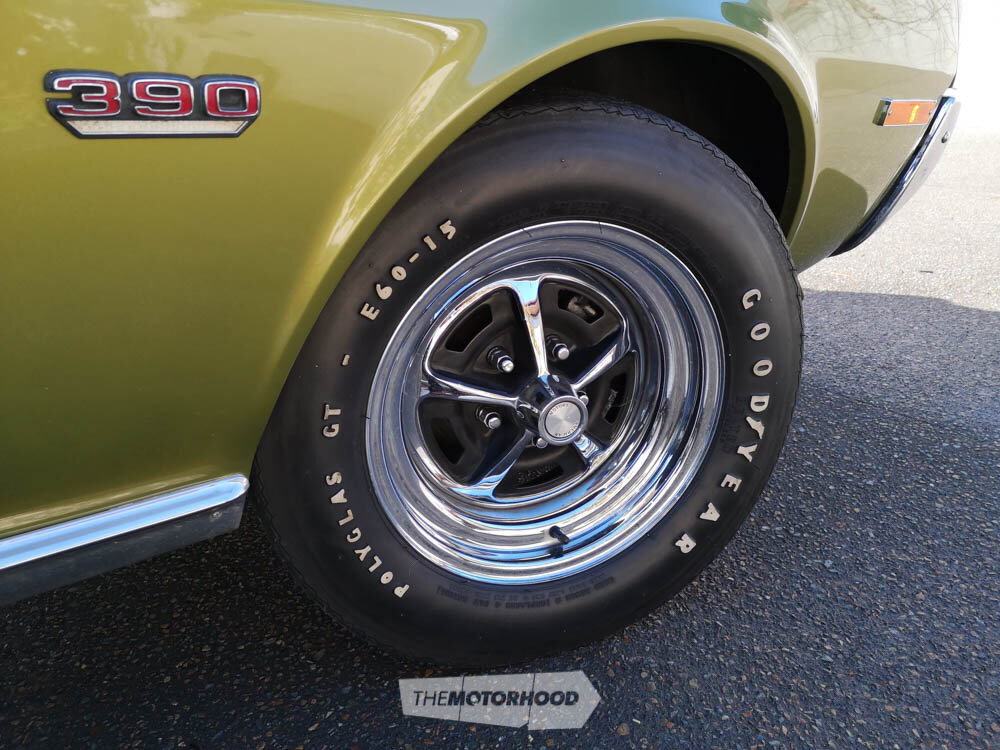

Simply the best
The Javelin and AMX were the creations of stylist George Teague, who had joined the company after working for other automakers in 1959. He was also credited with developing shared parts and platforms that helped make AMC-brand cars usefully cheaper, along with AMC’s refusal to indulge in the big three’s annual model-update circus.
The Javelin was well received and reviewed, often topping comparisons with its rivals. It was successful in racing, especially the less-handsome second-generation ’71 to ’74 cars. It was also the first pony car to be chosen for police duty. Donald’s last iteration of the first-generation car is just a great-looking package. It has all the right styling cues, but it eschews excess, simply looking right from every angle. It’s a muscle car for people who don’t like muscle cars.
That family introduction to this car meant it caught Donald’s attention on an American auction site. At the time, he was looking for a Mercedes 230 SL that his wife, Penny, had decided was her ultimate choice of car. The Javelin and a tidy-looking 230 Merc were among the 2000-odd cars going on the block over the four days of the Mecum sale in Indianapolis.
Donald was sufficiently impressed with the looks and apparent honesty of the Javelin listing to get someone to check it out. The report came back all positive. The inspector said that if he wasn’t already wedded to Mustangs he would buy it himself. Out of a possible five he scored it a 4.9 — and that was only because it didn’t have a Ford badge on it, Donald says.
Go Package
Donald was already registered to bid for the Mercedes but the Javelin would come up first. It had the ‘Go’ package, which meant it had a manual four-speed gearbox and the 390-cubic-inch (ci) (6.4-litre) engine, AMC’s own, featuring a bonnet scoop connected directly to the air cleaner, with a flap that opened via a solenoid when full noise was called for. The package included beefed-up suspension and an anti-sway bar; limited slip diff; and disc brakes, which work better than most of the era and are more than a match for the tyres. It was also a Mark Donohue edition, a tribute to the Can-Am racer, which meant it sported chin and ducktail spoilers and the racer’s signature on the boot. It also had the top-of-the-line SST trim, which delivered spiffy black corduroy seats with built-in headrests, woodgrain dash, and the half-vinyl landau roof. Donald remembered the SST branding from the top-of-the-line Rambler Ambassador SST in the family business. And he remembers seeing a Javelin occupying pride of place in the company’s Queen Street showroom for a few seasons.
Donald checked in on the auction and saw the cars coming up on the first couple of days whipping through at high speed — less than a minute in most cases. He called someone who would bid on the Javelin for him via phone. Donald told him just to keep going until he said stop. Happily, the bidding stopped in the mid 30s so Donald became the owner of his first muscle car.
The only problem, he said, was that he now felt obliged to step up for the Mercedes too. Donald could hardly tell his wife that he had intended to buy her a car for her upcoming significant birthday but instead ended up buying one for himself.
The Javelin duly arrived and, Donald said, it was probably better than expected. “I just fell in love with it immediately,” he says. He recognized the recessed door handles from other AMC cars, which confirmed that it was part of the family. Everything appeared to be totally original, although close inspection showed it had probably been repainted at some point in the latter stages of its 50 years — to be expected, as very few original paint jobs from that era have kept their shine over this distance. The glossy lemon-lime green on the outside panels is a minutely different shade from that of the door inners.
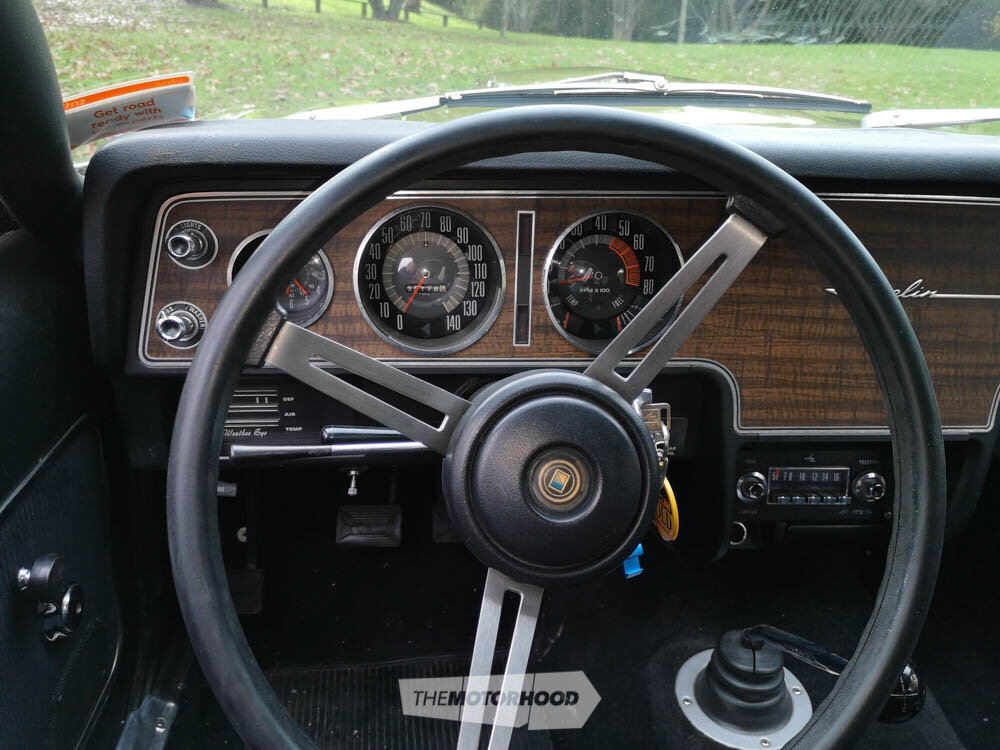
Knowing when to stop
Everything else indicates the 55,000 miles on the clock are genuine, including a couple of spots of rust bubbling up behind the rear wheel arches where two skins are known to trap moisture. The car had apparently been in a collection of 350 cars owned by Ray Stilman, who had decided to sell off some lower end cars to make room for more expensive collectables.
After going over the car, Donald was happy to stop at just replacing the hoses, the complete exhaust system, a leaking rear main seal, and an engine valley cover gasket. The team which looks after his cars was keen to do a rebuild, but Donald held off, saying it was fine as it was. He’s happy to use it for trips to the shops and other errands without worrying too much. He lent it for a time to his son who is part of New Zealand’s high-performance rowing squad based at Karapiro. The Javelin only improved his popularity in the squad, even though he said he’d only done big drifts and skids on the grass.
Donald says that the car has picked up a couple of chips in the paint in the four years he has owned it but he isn’t precious about that. The rust will be attended to in good time. In the meantime, he enjoys its honesty and usability. Especially in contrast to the Mercedes, which didn’t turn out to be such a bargain. The SL, which was rated three out of five in the pre-sale inspection, arrived with much more fundamental faults than that score would indicate. It is now undergoing a bare-metal restoration, and has been making strident and continuous demands on the budget.
Under the Javelin’s bonnet the first thing that strikes you is the open air cleaner, as the lid is attached to the bonnet. The four-barrel carb and engine are largely hidden by hoses and what not, and the rocker covers are purely functional, not dressed to impress. The engine might also have been overhauled at some stage, as the block is a different shade of Hammerite blue-green to some of the other hardware. The red and white branded AMC-branded screen-washer bag is a nice touch.
In the boot, a fabric-and-rubber floor mat is giving up its unequal struggle with oxidative ageing but it’s clearly original and can stay in place a while yet. A modern fire extinguisher is a Donald addition. Stuck to the underside of the boot lid is a frayed sticker giving instructions on the use of the jack — a companion piece to the mat. You can buy replacements but Donald cherishes this three-dimensional patina and is resisting the urge to restore. Every renewed item only highlights the contrast between new and old and increases the pressure to renew everything else around it.

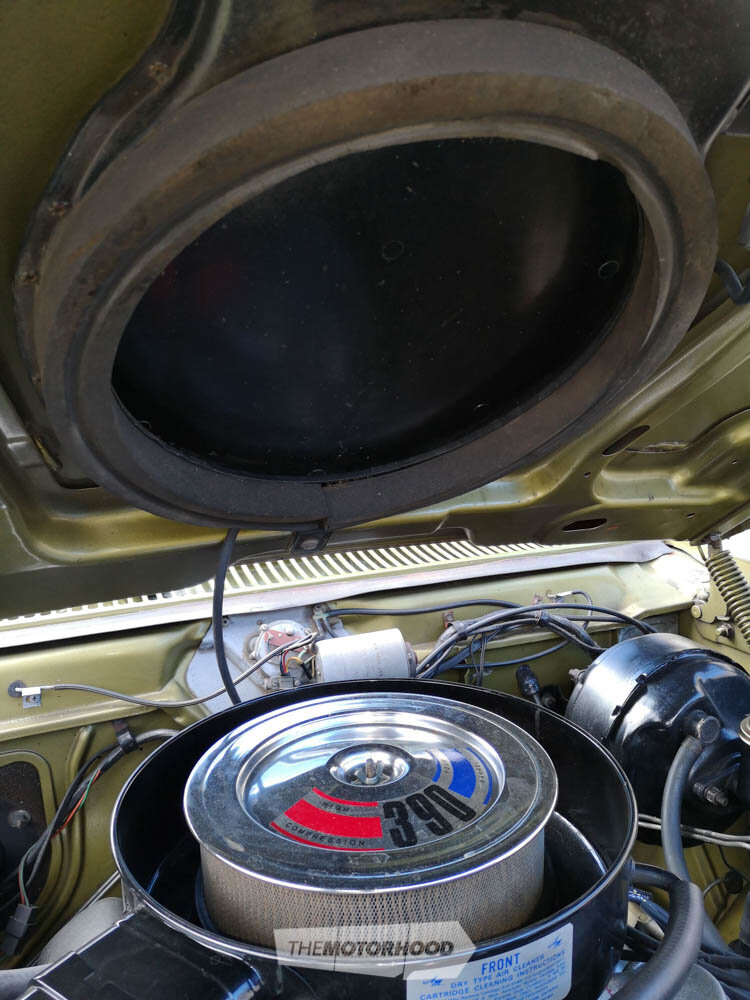

Period charm
The cabin is similarly authentic. The black headlining is fine; the sun visors do not sag; the black corduroy seats are both comfortable and show few signs of wear. The wood-effect dash is as convincing as a tinsel Christmas tree, and the regularity of the gaps in the plastic are on a par with those on the rest of the car — lazily unimpressive — but it’s all the more authentically American for that. The pedal covers are slightly worn, again matching the car’s mileage and, like the rest of the drivetrain, it has plenty of life left in it.
A turn of the key brings the big V8 to throbbing life. Donald has warmed the engine, so a few dabs of the throttle blare out a healthy bark, and the body rocks in concert. The beast has stirred but it’s not one of those angry ticking, rattling monsters that seem to choke on their own fumes at low revs, and seem only too willing to bite their owners.
The seatbelt is another nice period piece. You have to thread a metal hoop on the chest belt over the tab on the outer lap belt before plugging the pair into the catch on the inboard end of the lap belt. Clearly they didn’t expect it to see much use.
Looking over the bulging bonnet and easing this big wide car over Donald’s complicated driveway is less of a challenge than I imagined. The steering spins with typically American little-finger lightness. You know the torquey engine will drag it over the lumpy bits without any attention in second, and the bonnet’s square corners make the car easy to aim.

Another roadside attraction
On the road, the car simply gets easier and easier to drive. It is in every sense, classic American motoring. I don’t bother with the AM radio, the V8 offering the right soundtrack. A few roundabouts call for some generous wheel twirling, regardless of the massive assistance. Gear changes are largely unnecessary but are easily accomplished, and the thin indicator stalk has a satisfyingly positive click that speaks of metal, not plastic, internals.
A tool down the motorway sees the car in its element. A shove on the pedal catches the car by surprise for half a second, but then it swallows the fuel and roars into life, delivering a satisfying shove in the back. Overtaking is a little challenging, as there is only a driver’s side mirror at present, and the back view over the rear quarter is hampered by those long vinyl-covered buttresses, but it can be accomplished with care.
Back on suburban roads, the car is once again on its best behaviour, making the normal cut and thrust in traffic no more challenging than in a modern car but with the added fun of a manual gearbox, a big, thin-rimmed steering wheel to play with, and a subtle-but-satisfying accompaniment of workmanlike noises from the body and suspension.
That paint job, the unmistakable American proportions, and that serious-sounding V8 always attract attention. You can almost see the question forming in their minds. “What is it?”
